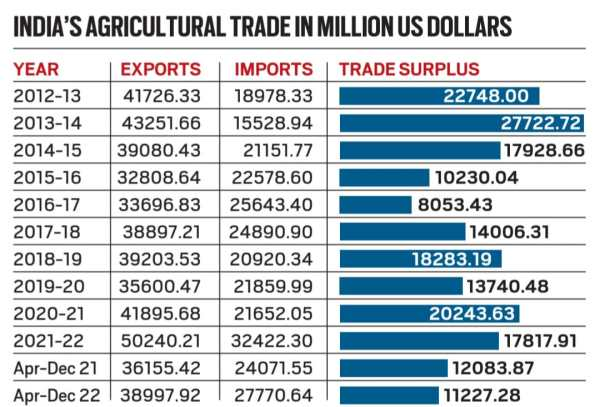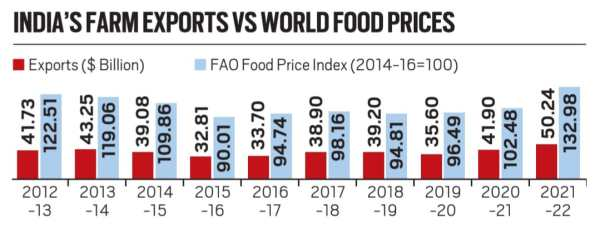Economy
India’s Farm Exports
- 14 Feb 2023
- 7 min read
Prelims: APEDA, Rice and Sugar, Agri Export Policy, TIES.
Mains: India’s Farm Exports and Imports.
Why in News?
The agriculture sector in India has experienced buoyant growth in the past two years.
- India’s agricultural exports are poised to scale a new peak in the financial year ending March 31, 2023. But so are imports, bringing down the overall farm trade surplus.
What are the Agri-Stats?
- The value of farm exports in April-December 2022 was 7.9% higher (USD 39 Billion) than the USD 36.2 bn for the corresponding period of the previous year.
- However, imports have grown 15.4% (USD 27.8 bn) in Apr-Dec 2022, over the USD 24.1 bn for Apr-Dec 2021.
- As a result, there has been a further shrinking of the surplus on the farm trade account.
- The two big contributors to India’s agri-export growth have been Rice and Sugar.
- Rice: India in 2021-22 shipped out an all-time-high 21.21 million tonnes (mt) of rice valued at USD 9.66 billion.
- That included 17.26 mt of non-basmati and 3.95 mt of basmati rice.
- Sugar: Sugar exports hit a record value of USD 4.60 billion in 2021-22, as against USD 2.79 billion in last fiscal.
- This fiscal has seen a further surge of 43.6%, from USD 2.78 billion in April-December 2021 to USD 3.99 billion in April-December 2022.
- Rice: India in 2021-22 shipped out an all-time-high 21.21 million tonnes (mt) of rice valued at USD 9.66 billion.
- However, exports of some big-ticket items have faltered or slowed, such as spices, wheat, buffalo meat etc.
What about the Imports?
- Vegetable Oil:
- According to the Solvent Extractors’ Association of India, India’s total edible oil imports rose from 13.13 mt in 2020-21 to 14.03 mt in the 2021-22 oil year (Nov-Oct), and increased further by 30.9% from 2.36 mt in Nov-Dec 2021 to 3.08 mt in Nov-Dec 2022.
- Cotton:
- India has turned from a net exporter to a net importer of cotton.
- Exports collapsed to USD 512.04 million in April-December, 2022 (from USD 1.97 billion in April-December 2021) and imports have also soared from USD 414.59 million to USD 1.32 billion for the same period.
- Cashew:
- During April-December 2022, imports have posted a 64.6% rise to USD 1.64 billion from USD 996.49 million in April-December 2021, even as exports of cashew products have plummeted from USD 344.61 million to USD 259.71 million for the same period.
What are the Related Initiatives?
How India’s Farm Performance is Linked to International Commodity Prices?
- The UN Food and Agriculture Organization’s (FAO) Food Price Index — having a base value of 100 for the 2014-16 period — averaged 122.5 points in 2012-13 and 119.1 points in 2013-14.
- Those were the years when India’s agri-exports were at USD 42-43 billion.
- As the index crashed to 90-95 points in 2015-16 and 2016-17, so did exports to USD 33-34 billion.
- The FAO index peaked at 159.7 points in March 2022, just after the Russian invasion of Ukraine. Since then, it has fallen every month, with the latest reading of 131.2 points for January 2023 the lowest after the 129.2 points of September 2021.
- More than a general export slowdown, it’s the growth in imports that should be cause for concern.
- Going by past correlation i.e., when the index was high, exports were high, and when it was low, exports were low. Currently, the index has been falling, which may lead to a slowdown in India's farm exports and an increase in imports.
- In the event, the focus of policymakers too, may have to shift from being pro-consumer (to the extent of banning/ restricting exports) to pro-producer (providing tariff protection against unbridled imports).
Way Forward
- Clearly, the effects of not allowing new genetic modification (GM) technologies after the first-generation Bt cotton are showing, and impacting exports as well. A proactive approach is required in edible oils as well, where planting of GM hybrid mustard has been permitted with great reluctance — and which is now a matter before the Supreme Court.
UPSC Civil Services Examination Previous Year Question (PYQ)
Q1. Among the following, which one is the largest exporter of rice in the world in the last five years? (2019)
(a) China
(b) India
(c) Myanmar
(d) Vietnam
Ans: (b)
- India has been the world’s top rice exporter since the beginning of this decade primarily owing to the lift of ban on export of non-basmati varieties of rice by GoI in 2011.
- India replaced Thailand in 2011-12 to become the largest rice exporter of the world.
- Therefore, option (b) is the correct answer.
Q2. Consider the following statements: (2018)
- The quantity of imported edible oils is more than the domestic production of edible oils in the last five years.
- The Government does not impose any customs duty on all the imported edible oils as a special case.
Which of the statements given above is/are correct?
(a) 1 only
(b) 2 only
(c) Both 1 and 2
(d) Neither 1 nor 2
Ans: (a)






